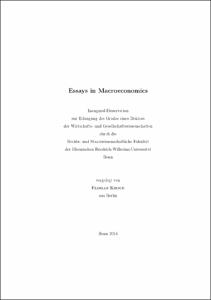Essays in Macroeconomics

Essays in Macroeconomics

| dc.contributor.advisor | Müller, Gernot J. | |
| dc.contributor.author | Kirsch, Florian | |
| dc.date.accessioned | 2020-04-22T18:17:53Z | |
| dc.date.available | 2020-04-22T18:17:53Z | |
| dc.date.issued | 21.12.2016 | |
| dc.identifier.uri | https://hdl.handle.net/20.500.11811/6834 | |
| dc.description.abstract | This thesis consists of three independent chapters which deal with macroeconomic topics that drew much attention in the years of financial and economic crisis since 2007. Chapter 1 analyzes how the availability of financial assistance by international lenders, like the International Monetary Fund (IMF), affects the default incentives of a government. The analysis is done using a quantitative model of sovereign default. In this model a default is the optimal decision of the government and can be induced either by bad fundamentals or by self-fulfilling crises due to runs by international investors. Financial assistance is provided by an official lender. It is senior to market debt and associated with conditionality in the form of debt targets. The quantitative analysis, for which the model is calibrated to match Argentinean data, shows that the probability of a default on market debt is higher when financial assistance is available. This result can be explained by the fact, that the financial assistance works as an insurance for the investors. For given fundamentals the government is less likely to default when it has the possibility to receive financial assistance. However, there is a counteracting general equilibrium effect. Given the smaller default risk, the investors are willing to pay a higher price for government bonds. This in turn induces the government to borrow more. The resulting higher average debt levels then lead to more defaults in equilibrium. Chapter 2 also deals with the topic of sovereign default. It analyzes to what extent a standard quantitative model of sovereign default can explain the developments of sovereign interest rate spreads observed for European countries during the crisis in the recent years. More specifically, the model is used to analyze the case of Italy in the time of the crisis on the European sovereign debt markets. The model features default as the optimal decision of the government, includes long-term debt and allows for self-fulfilling default crises. For the quantitative analysis the model is calibrated to match important moments of the Italian data. The analysis shows that while the model is able to match some aspects of the data, it predicts a counterfactual default in the early periods of the crisis, when output was extremely low. Furthermore, the quantitative results suggest that the development of the interest rate spreads are influenced by other factors than only the Italian fundamentals. Interestingly, the long maturity of Italian debt leaves only little room for self-fulfilling crises as considered in the model. Chapter 3 turns to a different topic that has played an important role in the analysis of the financial and economic crisis. Using vector autoregressive (VAR) models, the chapter provides an empirical analysis of the effects of monetary policy shocks and credit shocks on house prices and the broader economy in the United States and the United Kingdom. The shocks are identified using sign restrictions derived from the impulse response functions of a dynamic stochastic general equilibrium (DSGE) model that includes house prices and collateralized credit. The empirical analysis shows that in the U.S. a negative monetary shock leads to a decline in house prices, while there is no clear effect in the U.K. The credit shock, in contrast, has no significant effect on house prices when U.S. data is considered, but has a short-term negative effect in the U.K. The chapter also provides a historical decomposition to shed light on the role of credit and monetary shocks for house price developments. | en |
| dc.language.iso | eng | |
| dc.rights | In Copyright | |
| dc.rights.uri | http://rightsstatements.org/vocab/InC/1.0/ | |
| dc.subject.ddc | 330 Wirtschaft | |
| dc.title | Essays in Macroeconomics | |
| dc.type | Dissertation oder Habilitation | |
| dc.publisher.name | Universitäts- und Landesbibliothek Bonn | |
| dc.publisher.location | Bonn | |
| dc.rights.accessRights | openAccess | |
| dc.identifier.urn | https://nbn-resolving.org/urn:nbn:de:hbz:5-45928 | |
| ulbbn.pubtype | Erstveröffentlichung | |
| ulbbnediss.affiliation.name | Rheinische Friedrich-Wilhelms-Universität Bonn | |
| ulbbnediss.affiliation.location | Bonn | |
| ulbbnediss.thesis.level | Dissertation | |
| ulbbnediss.dissID | 4592 | |
| ulbbnediss.date.accepted | 18.02.2016 | |
| ulbbnediss.fakultaet | Rechts- und Staatswissenschaftliche Fakultät | |
| dc.contributor.coReferee | Hintermaier, Thomas |
Files in this item
This item appears in the following Collection(s)
-
E-Dissertationen (288)




